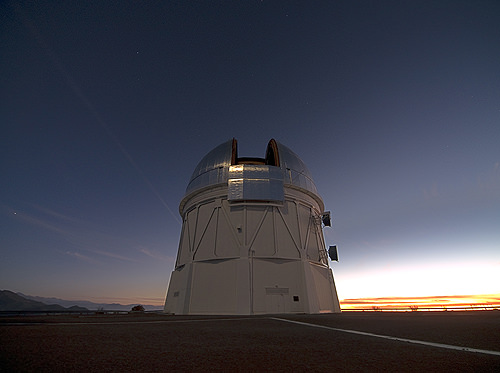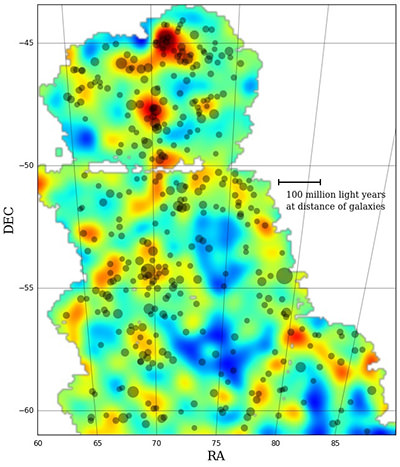This week, scientists with the Dark Energy Survey (DES) collaboration released the first in a series of detailed maps charting the distribution of dark matter inferred from its gravitational effects. The new maps confirm current theories that suggest galaxies will form where large concentrations of dark matter exist. The new data show large filaments of dark matter where visible galaxies and galaxy clusters lie and cosmic voids where very few galaxies reside.
“Our analysis so far is in line with what the current picture of the universe predicts,” said Chihway Chang from the Swiss Federal Institute of Technology (ETH) in Zurich, a co-leader of the analysis. “Zooming into the maps, we have measured how dark matter envelops galaxies of different types and how together they evolve over cosmic time.”
The research and maps, which span a large area of the sky, are the product of a massive effort of an international team from the US, UK, Spain, Germany, Switzerland, and Brazil. They announced their new results at the American Physical Society (APS) meeting in Baltimore, Maryland.
According to cosmologists, dark matter particles stream and clump together over time in particular regions of the cosmos, often in the same places where galaxies form and cluster. Over time, a “cosmic web” develops across the universe. Though dark matter is invisible, it expands with the universe and feels the pull of gravity. Astrophysicists then can reconstruct maps of it by surveying millions of galaxies, much like one might infer the shifting orientation of a flock of birds from its shadow moving along the ground.
DES scientists created the maps with one of the world’s most powerful digital cameras, the 570-megapixel Dark Energy Camera (DECam), which is particularly sensitive to the light from distant galaxies. It is mounted on the 4-meter Victor M. Blanco Telescope, located at the Cerro Tololo Inter-American Observatory in northern Chile. Each of its images records data from an area 20 times the size of the moon as seen from earth.
In addition, DECam collects data nearly ten times faster than previous machines. According to David Bacon, at the University of Portsmouth’s Institute of Cosmology and Gravitation, “This allows us to stare deeper into space and see the effects of dark matter and dark energy with greater clarity. Ironically, although these dark entities make up 96% of our universe, seeing them is hard and requires vast amounts of data.”

The telescope and its instruments enable precise measurements utilizing a technique known as “gravitational lensing.” Astrophysicists study the small distortions and shear of images of galaxies due to the gravitational pull of dark matter around them, similar to warped images of objects in a magnifying glass, except that the lensed galaxies observed by the DES scientists are at least 6 billion light-years away.
Chang and Vinu Vikram (Argonne National Laboratory) led the analysis, with which they traced the web of dark matter in unprecedented detail across 139 square degrees of the southern hemisphere. “We measured the barely perceptible distortions in the shapes of about 2 million galaxies to construct these new maps,” Vikram said. This amounts to less then 0.4% of the whole sky, but the completed DES survey will map out more than 30 times this area over the next few years.
They submitted their research paper for publication in an upcoming issue of the Monthly Notices of the Royal Astronomical Society, and the DES team publicly released it as part of a set of papers on the arXiv.org server on Tuesday.
The precision and detail of these large contiguous maps being produced by DES scientists will allow for tests of other cosmological models. “I’m really excited about what these maps will tell us about dark matter in galaxy clusters especially with respect to theories of modified gravity,” says Robert Nichol (University of Portsmouth). Einstein’s model of gravity, general relativity, could be incorrect on large cosmological scales or in the densest regions of the universe, and ongoing research with the Dark Energy Survey will facilitate investigations of this.


Strange that the DES actually traces Dark Matter and not it’s name sake. Why is that?
I’m really interested to see how the detailed Dark Matter map of distribution lines up with the CMB. I think I would be most surprised if there was no correlation between the two!
They mapped the Luminiferous Ether, excuse me, the Dark Matter around all those galaxies? Did they find the Easter Bunny and the Tooth Fairy, too?
To answer the question about dark energy, the DES needs to map out a wider volume and study their systematic uncertainties in more detail before they will be able to perform analyses probing dark energy that would be competitive to those done with other surveys. (In other words, we have to be patient.) On the question about the dark matter distribution and the large-scale structure in the CMB, some people have indeed studied correlations between them, and I’m sure there are plans in the works to do the same with the DES results.
Ramin,
Thanks for the follow up! Hope to read more from you about future work in the field of cosmology soon 🙂
-Mitchell Tubbs